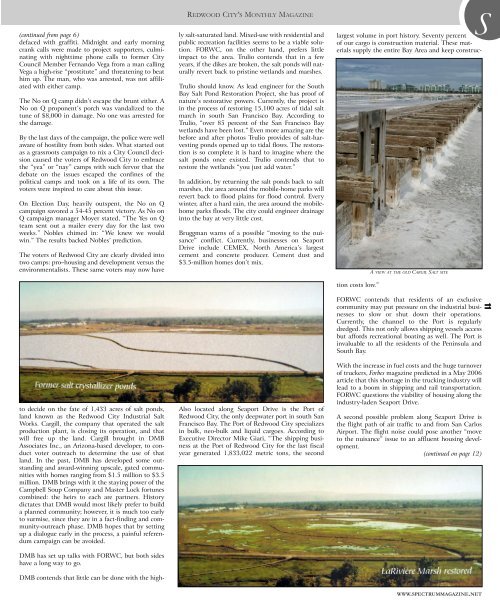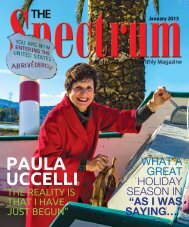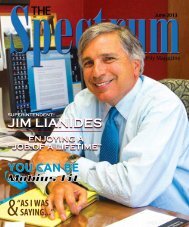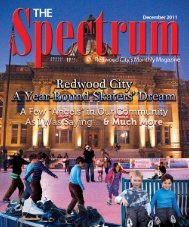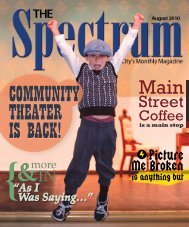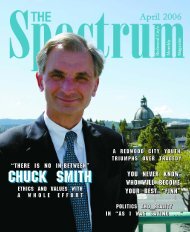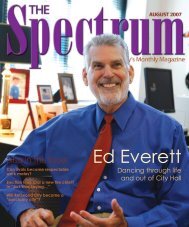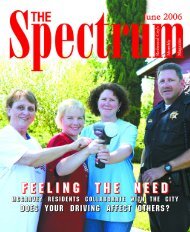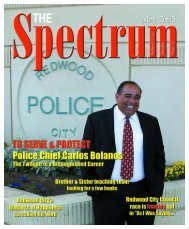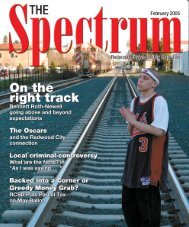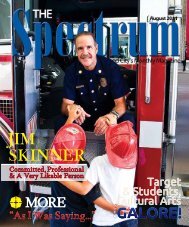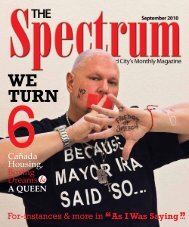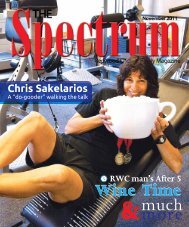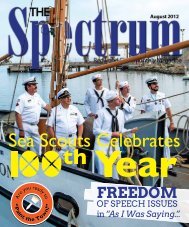S - The Spectrum Magazine - Redwood City's Monthly Magazine ...
S - The Spectrum Magazine - Redwood City's Monthly Magazine ...
S - The Spectrum Magazine - Redwood City's Monthly Magazine ...
Create successful ePaper yourself
Turn your PDF publications into a flip-book with our unique Google optimized e-Paper software.
(continued from page 6)<br />
defaced with graffiti. Midnight and early morning<br />
crank calls were made to project supporters, culminating<br />
with nighttime phone calls to former City<br />
Council Member Fernando Vega from a man calling<br />
Vega a high-rise “prostitute” and threatening to beat<br />
him up. <strong>The</strong> man, who was arrested, was not affiliated<br />
with either camp.<br />
<strong>The</strong> No on Q camp didn’t escape the brunt either. A<br />
No on Q proponent’s porch was vandalized to the<br />
tune of $8,000 in damage. No one was arrested for<br />
the damage.<br />
By the last days of the campaign, the police were well<br />
aware of hostility from both sides. What started out<br />
as a grassroots campaign to nix a City Council decision<br />
caused the voters of <strong>Redwood</strong> City to embrace<br />
the “yea” or “nay” camps with such fervor that the<br />
debate on the issues escaped the confines of the<br />
political camps and took on a life of its own. <strong>The</strong><br />
voters were inspired to care about this issue.<br />
On Election Day, heavily outspent, the No on Q<br />
campaign savored a 54-45 percent victory. As No on<br />
Q campaign manager Moyer stated, “<strong>The</strong> Yes on Q<br />
team sent out a mailer every day for the last two<br />
weeks.” Nobles chimed in: “We knew we would<br />
win.” <strong>The</strong> results backed Nobles’ prediction.<br />
<strong>The</strong> voters of <strong>Redwood</strong> City are clearly divided into<br />
two camps: pro–housing and development versus the<br />
environmentalists. <strong>The</strong>se same voters may now have<br />
REDWOOD CITY’S MONTHLY MAGAZINE<br />
ly salt-saturated land. Mixed-use with residential and<br />
public recreation facilities seems to be a viable solution.<br />
FORWC, on the other hand, prefers little<br />
impact to the area. Trulio contends that in a few<br />
years, if the dikes are broken, the salt ponds will naturally<br />
revert back to pristine wetlands and marshes.<br />
Trulio should know. As lead engineer for the South<br />
Bay Salt Pond Restoration Project, she has proof of<br />
nature’s restorative powers. Currently, the project is<br />
in the process of restoring 15,100 acres of tidal salt<br />
march in south San Francisco Bay. According to<br />
Trulio, “over 85 percent of the San Francisco Bay<br />
wetlands have been lost.” Even more amazing are the<br />
before and after photos Trulio provides of salt-harvesting<br />
ponds opened up to tidal flows. <strong>The</strong> restoration<br />
is so complete it is hard to imagine where the<br />
salt ponds once existed. Trulio contends that to<br />
restore the wetlands “you just add water.”<br />
In addition, by returning the salt ponds back to salt<br />
marshes, the area around the mobile-home parks will<br />
revert back to flood plains for flood control. Every<br />
winter, after a hard rain, the area around the mobilehome<br />
parks floods. <strong>The</strong> city could engineer drainage<br />
into the bay at very little cost.<br />
Bruggman warns of a possible “moving to the nuisance”<br />
conflict. Currently, businesses on Seaport<br />
Drive include CEMEX, North America’s largest<br />
cement and concrete producer. Cement dust and<br />
$3.5-million homes don’t mix.<br />
DMB contends that little can be done with the high-<br />
S<br />
largest volume in port history. Seventy percent<br />
of our cargo is construction material. <strong>The</strong>se materials<br />
supply the entire Bay Area and keep construction<br />
costs low.”<br />
A VIEW AT THE OLD CARGIL SALT SITE<br />
FORWC contends that residents of an exclusive<br />
community may put pressure on the industrial businesses<br />
to slow or shut down their operations.<br />
Currently, the channel to the Port is regularly<br />
dredged. This not only allows shipping vessels access<br />
but affords recreational boating as well. <strong>The</strong> Port is<br />
invaluable to all the residents of the Peninsula and<br />
South Bay.<br />
11<br />
to decide on the fate of 1,433 acres of salt ponds,<br />
land known as the <strong>Redwood</strong> City Industrial Salt<br />
Works. Cargill, the company that operated the salt<br />
production plant, is closing its operation, and that<br />
will free up the land. Cargill brought in DMB<br />
Associates Inc., an Arizona-based developer, to conduct<br />
voter outreach to determine the use of that<br />
land. In the past, DMB has developed some outstanding<br />
and award-winning upscale, gated communities<br />
with homes ranging from $1.5 million to $3.5<br />
million. DMB brings with it the staying power of the<br />
Campbell Soup Company and Master Lock fortunes<br />
combined: the heirs to each are partners. History<br />
dictates that DMB would most likely prefer to build<br />
a planned community; however, it is much too early<br />
to surmise, since they are in a fact-finding and community-outreach<br />
phase. DMB hopes that by setting<br />
up a dialogue early in the process, a painful referendum<br />
campaign can be avoided.<br />
DMB has set up talks with FORWC, but both sides<br />
have a long way to go.<br />
Also located along Seaport Drive is the Port of<br />
<strong>Redwood</strong> City, the only deepwater port in south San<br />
Francisco Bay. <strong>The</strong> Port of <strong>Redwood</strong> City specializes<br />
in bulk, neo-bulk and liquid cargoes. According to<br />
Executive Director Mike Giari, “<strong>The</strong> shipping business<br />
at the Port of <strong>Redwood</strong> City for the last fiscal<br />
year generated 1,833,022 metric tons, the second<br />
With the increase in fuel costs and the huge turnover<br />
of truckers, Forbes magazine predicted in a May 2006<br />
article that this shortage in the trucking industry will<br />
lead to a boom in shipping and rail transportation.<br />
FORWC questions the viability of housing along the<br />
industry-laden Seaport Drive.<br />
A second possible problem along Seaport Drive is<br />
the flight path of air traffic to and from San Carlos<br />
Airport. <strong>The</strong> flight noise could pose another “move<br />
to the nuisance” issue to an affluent housing development.<br />
(continued on page 12)<br />
WWW.SPECTRUMMAGAZINE.NET


